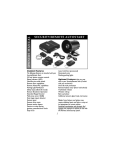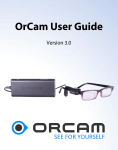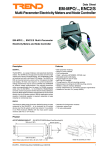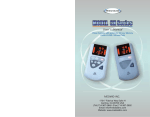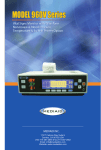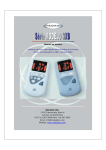Download Model 5340V User`s Manual - English: Low Res
Transcript
Model 5340V Pulse Oximeter For Veterinary Use User's Manual 5 34 0 V MEDIAID INC. 17517 Fabrica Way, Suite H, Cerritos CA 90703 USA Tel : 714 367 2848 Fax : 714 367 2852 Email: [email protected] Web: www.mediaidinc.com Model 5340V Pulse Oximeter For Veterinary Use User's Manual © Mediaid Inc - All rights reserved 1002-60017-002 Table of Contents Chapter 1 : Principles of Operation .............................................................. 1 Intended Uses .................................................................................................... 1 Principles of Pulse Oximetry .............................................................................. 1 Principle of Measuring Body Temperature ......................................................... 1 Mode of Displaying Oxygen Saturation .............................................................. 2 Principal Features ............................................................................................... 2 General Cautions ................................................................................................ 3 Environmental Cautions ..................................................................................... 3 Chapter 2 : Keys, Indicators, & Symbols ....................................................... 4 Front Button Panel ............................................................................................. 4 Audible Features ................................................................................................ 8 Symbols ............................................................................................................. 9 Chapter 3 : Operating the Model 5340V .................................................... 10 Measuring Pulse Oximetry ............................................................................... 10 Measuring Body Temperature .......................................................................... 11 Faulty Reading & Sensor Complication Prevention ......................................... 12 Setting the Volume Level of the Audible Indicator ............................................ 12 Reading & Setting Alarm Levels ....................................................................... 13 Silencing & Reactivating Alarms ....................................................................... 13 Power ............................................................................................................... 14 Data Transmission ............................................................................................ 15 Tests ................................................................................................................. 16 Chapter 4 : Maintaining the Model 5340V ................................................ 20 Cleaning Instructions ........................................................................................ 20 Troubleshooting ................................................................................................ 20 Chapter 5 : Equipment Specifications ....................................................... 21 Oxygen Saturation, Pulse Rate & Temperature ................................................ 21 Alarms .............................................................................................................. 21 Analog Outputs ................................................................................................. 21 Serial Communication ...................................................................................... 21 General ............................................................................................................. 21 Sensors ............................................................................................................ 22 Power Source ................................................................................................... 22 Environmental Conditions ................................................................................. 22 Equipment Classifications ................................................................................ 22 Chapter 6 : Mediaid Inc., Limited Warranty ................................................ 23 Applicability of Warranty ................................................................................... 23 Warranty Coverage ........................................................................................... 23 Mediaid Inc. Problem Correction Plan .............................................................. 24 Owner’s Registration ........................................................................................ 24 Chapter 7 : Order Information .................................................................. 25 Contact Information .......................................................................................... 25 Product Information .......................................................................................... 25 Warranty Registration Form ..................................................................... 27 Principles of Operation Chapter 1: Principles of Operation Intended Uses The Model 5340V is intended to continuously monitor an animal’s arterial oxygen saturation and heart rate. It also provides body temperature information every two minutes or on command. Principles of Pulse Oximetry WARNING Before using the Model 5340V, the user should become thoroughly familiar with the information in this manual and with all information included with the sensors. The Mediaid Model 5340V Pulse Oximeter is designed to measure the percentage oxygen saturation (%SpO2) of functional hemoglobin. Non-invasive arterial oxygen saturation measurement is obtained by directing red and infrared light through a pulsating vascular bed. The pulsating arterioles in the path of the light beam cause a change in the amount of light detected by a photodiode. The pulse oximeter measures within the pulse waveform the ratio of transmitted red to infrared light, and thereby determines the oxygen saturation of arterial blood. The non-pulsatile signal is removed electronically for the purpose of calculation.Therefore, skin, bone and other non-pulsating substances do not interfere with the calculation of arterial oxygen saturation. Principle of Measuring Body Temperature The Mediaid Model 5340V’s temperature component is designed to measure the animal’s core temperature with a rectal thermistor sensor.The thermistor’s highly sensitive resistance decreases with increasing temperature. The LED display indicates the animal’s body temperature. PAGE Principles of Operation Mode of Displaying Oxygen Saturation The Model 5340V displays pulse oximetry data as follows: A normal steady display signifies that the pulse oximeter has received at least three intelligible pulses in the last 30 seconds. The display is updated each time a normal pulse is received. A blinking display indicates that the Model 5340V has received no usable pulses for at least 30 seconds. The displayed pulse oximetry readings are at least 30 seconds old. A blinking display with a 1-second warning tone every 10 seconds indicates that the Model 5340V has received no usable pulses for at least 60 seconds. The displayed pulse oximetry readings are at least 60 seconds old. Principal Features The Mediaid Model 5340V Pulse Oximeter is a portable, lightweight instrument designed to non-invasively monitor arterial oxygen saturation, heart rate and body temperature. The principal features of the Model 5340V are as follows: Displays with two bright Light Emitting Diodes (LEDS). Indicates oxygen saturation, heart rate, and temperature. Provides a constant readout of oxygen saturation in %SpO2 and heart rate in beats per minute (BPM). Issues an audible tone that sounds for each pulse and varies in pitch with oxygen saturation - falling in pitch with reduced saturation and rising in pitch as saturation increases. Sounds a double tone to indicate each time the animal’s body temperature is measured. Provides visual and audible alarms for oxygen saturation and pulse rate monitoring. Allows for data transmission through the DATA PORT. Performs a functional test at power-on. Additional diagnostics tests can be initiated manually. Alerts to a low-battery condition with a front-panel LED indicator. Powered by either standard electric power or an internal, rechargeable Nickel-Cadmium (NiCad) battery. Compatible with all Mediaid veterinary sensors with RJ12 connectors. PAGE Principles of Operation General Cautions Federal law (USA) restricts this device to sale by or on the order of a licensed veterinarian. Proper operation of the oximeter and sensors may be influenced by patient movement, dysfunctional hemoglobin and dyes. Become thoroughly familiar with the information in the User’s Manual and all accompanying documents before using the Model 5340V. Take appropriate measures (such as powering off the Model 5340V) to Ensure animal safety in case of abnormal conditions during operation of the Model 5340V. Do not attempt to modify or repair the Model 5340V. Dispose of the Model 5340V according to governmental regulations. Environmental Cautions Do not use in the presence of anesthetics or flammable agents. Do not allow any liquid to penetrate the instrument’s interior. Operate the Model 5340V in normal light conditions. Do not use near Magnetic Resonance Imaging (MRI) equipment. Keep away from other equipment, such as a defibrillator, which may affect the accuracy of pulse oximetry readings. Move the Model 5340V away from other electromagnetic emitting equipment if there are any interference problems. This device complies with electromagnetic compatibility standards EN550011 and EN60601-1-2. PAGE Keys, Indicators & Symbols Chapter 2: Keys, Indicators & Symbols 5340V Front Button Panel A. Power On/Off Key The unit is powered on with one short depression WARNING (less than one second) of the POWER ON/OFF KEY. A 1-second display and indicator test is performed A non-functioning LED automatically, and all Light Emitting Diodes (LEDs) segment may yield are illuminated. Carefully observe the LED displays inaccurate readings. for proper operation of all segments. A nonfunctioning segment will result in an incomplete numeral and possible erroneous reading. One long depression (3 seconds or longer) of the Power On/Off Key initiates the Internal Confidence and Diagnostic Tests (see section “Tests” in Chapter 3). B. Oxygen Saturation Display Whenever the pulse oximeter receives at least three (3) pulses during a 30-second period, the left LED displays the animal’s oxygen saturation levels. The display is updated with every normal pulse. PAGE Keys, Indicators & Symbols C. Pulse Rate Display Whenever the pulse oximeter receives at least three (3) pulses during a 30-second period, the right LED display shows the animal’s heart rate in beats-per-minute (BPM). D.Visual Pulse Rate Indicator As soon as a pulse is found, the heartbeat is indicated by a green LED. The VISUAL PULSE RATE INDICATOR simultaneously flashes with the animal’s pulse. It typically begins to flash a few seconds before numerical values for oxygen saturation and pulse rate are shown. WARNING A blinking display indicates that the Model 5340V has received NO usable pulses for at least 30 seconds. The displayed pulse oximetry readings are at least 30 seconds old. NOTE: If the unit is powered by battery and a pulse search is unsuccessful for any reason, Model 5340V automatically powers off after one minute of unsuccessful pulse search. E. Low Battery Indicator The LOW BATTERY INDICATOR illuminates when the battery is near depletion. In order to continue battery-only operation, the user needs to suspend measurements and recharge the battery (using the method described in section “POWER” in Chapter 3). NOTE: The pulse oximeter powers off shortly after a low-battery indication. The Model 5340V displays acronym if power-on is attempted during a low battery condition. F. Sensor Cable Connection All Mediaid pulse oximetry sensors with RJ12 connectors are compatible with the Model 5340V. To connect a sensor to the oximeter, align the plug with the jack on the oximeter and insert it gently until an audible “click” is heard — indicating that the plug tab is latched in place. To remove, squeeze the locking tab on the plug and slide the plug out of the jack. NOTE: The sensor might move slightly within the connector. G. Power Connection For electric power, plug the adaptor into the pulse oximeter’s POWER CONNECTION, and then plug the other end of the adaptor into a standard electrical outlet. (All Mediaid pulse oximeters are designed to be used with the adaptor provided by Mediaid Inc. at the time of purchase.) H. Power Indicator The green LED located on the bottom of the oximeter adjacent to the POWER CONNECTION illuminates when the Model 5340V is connected to electric power. PAGE Keys, Indicators, & Symbols I. Data Port The DATA PORT is used for serial and analog output. The DATA PORT should be used only for connection to equipment that complies with CSA/IEC/UL601-1. To eliminate risk of shock, take care not to touch the DATA PORT 8-pin Connector and the animal simultaneously. J. Alarm Off Key One short depression of the ALARM OFF KEY silences the alarm for a period of 60 seconds. One long depression of the ALARM OFF KEY completely disables the audible alarm. The LED displays show , the ALARM OFF INDICATOR begins to flash, and the pulse oximeter reverts to normal monitoring. Silenced alarms can be reactivated by one short depression of the ALARM OFF KEY. Disabled audible alarms are reactivated by one long depression of the ALARM OFF KEY. The LED displays show NOTE: Visual alarm indicators cannot be deactivated. K. Alarm Off Indicator The ALARM OFF INDICATOR illuminates and remains on constantly when alarms are silenced, and flashes when audible alarms are disabled. L. Oxygen Saturation Alarm Key One short depression of the OXYGEN SATURATION ALARM KEY toggles the display between the high and low alarm settings, as shown by the HI/LO ALARM INDICATORS. These alarm settings can be adjusted with the INCREMENT or DECREMENT KEY. The alarm settings will be retained in memory until changed by the user. Exception: When the low-saturation alarm is set below 80%, it returns to 80% at the next power?up. The saturation alarm factory settings are: high 100% and low 85%. The high-saturation alarm can be disabled by setting it at 100%. The Model 5340V reverts to normal monitoring after a 5-second period of key inactivity. M. Pulse Rate Alarm Key One short depression of the PULSE RATE ALARM KEY toggles the display between the high and low alarm settings as shown by the HI/LO ALARM INDICATORS. These alarm settings can be adjusted with the INCREMENT or DECREMENT KEY. The alarm settings are retained in memory until changed by the user. The pulse-rate alarm factory settings are: high 140 BPM and low 50 BPM. The Model 5340V reverts to normal animal monitoring after a 5-second period of key inactivity. Temperature measurements can be initiated manually at any time with one long depression of the PULSE RATE ALARM KEY. N. Increment & Decrement Keys The Model 5340V’s pulse-tone volumes can be adjusted using the INCREMENT or DECREMENT KEY. There are three levels of audible pulse-tones, and “off.” The pulse tone volume can be increased with the INCREMENT KEY and decreased or silenced with the DECREMENT KEY. Alarm settings are also adjusted with these keys. PAGE Keys, Indicators, & Symbols O. Hi/Lo Alarm Indicators The HI/LO ALARM INDICATORS are located beneath the OXYGEN SATURATION ALARM and PULSE RATE ALARM KEYS.These indicators flash when the animal’s oxygen saturation or pulse rate reaches the preset high or low alarm limits. In order to set the high alarm limits, the HI ALARM INDICATOR must be illuminated.To set the low alarm limits, the LO ALARM INDICATOR must be illuminated. P. Temperature Display When a thermistor sensor is being used, the two LED displays indicate the animal’s body temperature in degrees Celsius or Fahrenheit. Once monitoring begins, the temperature is displayed every two minutes and is announced with a double-beep audible tone. The temperature can also be measured at any time by one long depression of the PULSE RATE ALARM KEY.One long depression of the OXYGEN SATURATION ALARM KEY toggles the temperature setting (Cº or Fº). PAGE Keys, Indicators, & Symbols Audible Features Oxygen Saturation Indicator A varying pitch of the audible tone signals a change in the oxygen saturation level a falling pitch indicates a decreasing oxygen saturation level, whereas a raising pitch indicates an increasing oxygen saturation level. Pulse Rate Indicator A beeping audible tone signals the heartbeat. There are three volume levels of pulsetones, and “off.” The pulse-tone volume can be increased with the INCREMENT KEY and decreased or silenced with the DECREMENT KEY . Temperature Indicator A double-beep audible tone sounds each time the animal’s temperature is displayed. Alarm Indicator Alarm conditions are generated only after an initial pulse has been detected. Alarm tones are automatically silenced after the alarm condition goes away. The HIGH PRIORITY alarm tones sound continuously at the highest frequency and highest volume. HIGH PRIORITY alarms are caused by conditions such as low and high oxygen saturation and pulse rate, no pulse, excessive ambient light, and other error conditions. The MEDIUM PRIORITY alarm tones sound for 0.75 seconds every 5 seconds at the highest frequency and highest volume. MEDIUM PRIORITY alarms are caused by measuring problems such as a disconnected sensor, too thin or thick tissue, or a faulty sensor. The LOW PRIORITY alarm tones sound for one second every 10 seconds at the lowest frequency and highest volume. LOW PRIORITY alarms are caused by excessive animal movement or an irregular heartbeat. PAGE Keys, Indicators, & Symbols Symbol Definition Oxygen Saturation Display Pulse Rate Display Power On/Off KEY Alarm Off KEY Oxygen Saturation Alarm KEY Pulse Rate Alarm KEY Increment Key Decrement Key Data Port Sensor Cable Connection Power Connection Low Battery Indicator Attention: Consult Accompanying Documents Non-anesthetic Proof Type BF Applied Part HI/LO Alarm Indicator PAGE Operating the Model 5340V Chapter 3: Operating the Model 5340V WARNING To ensure personal safety and proper operation of the Model 5340V, adhere to ALL directions, information, and cautions stipulated within this document. WARNING Animal movement, lightsource interference, or any other disturbances that occur for more than 30 seconds are indicated by a blinking display. The displayed pulse oximeter readings are at least 30 seconds old.. WARNING A non-functioning LED segment may yield inaccurate pulse oximetry readings. WARNING Do NOT silence the audible alarms if the safety of the animal could be compromised. PAGE Measuring Pulse Oximetry To measure and display pulse oximetry, follow these steps: 1) Choose an appropriate sensor. 2) Place the sensor according to the instructions with the sensor. 3) Connect the sensor to the SENSOR CABLE CONNECTION of the Model 5340V. NOTE: The sensor might move slightly within the connector. 4) Follow all guidelines in section “Faulty Reading & Sensor Complication Prevention” to prevent faulty readings and sensor complications. 5) Power on the unit with one short depression of the POWER ON/OFF KEY. The Model 5340V tests the displays and the indicators with the initiated POWER-UP TEST. NOTE: One long depression of the POWER ON/OFF KEY initiates the Internal Confidence Tests (see section “Internal Confidence Tests” in Chapter 3). 6) Check that all LED segments light up during the POWER-UP TEST. 7) Be sure that the VISUAL PULSE RATE INDICATOR is flashing during the monitoring process 8) Read the animal’s oxygen saturation and heart rate off of the OXYGEN SATURATION and PULSE RATE DISPLAY. 9) Listen to the PULSE RATE INDICATOR. NOTE: There are three volume levels of audible pulse tones, and “off”. The tone varies in pitch with oxygen saturation - falling in pitch with reduced saturation and rising in pitch as saturation increases.See section “Setting the Volume Level of the Audible Indicator” in Chapter 3. 10) Set the pulse oximetry and heart rate alarm levels according to section “Reading and Setting Alarm Levels” in Chapter 3. 11) Silence and reactivate alarms according to section “Silencing and Reactivating Alarms” in Chapter 3. Operating the Model 5340V Measuring Body Temperature To measure and display body temperature, follow these steps: 1) Choose an appropriate sensor. 2) Place the sensor on the animal according to the WARNING instructions included with each sensor. During insertion of the 3) Connect the sensor to the SENSOR CABLE CONRectal sensor, rectal NECTION of the Model 5340V. perforation can occur if NOTE: The sensor might move slightly within the excessive force is used. If connector. resistence is encountered, Follow all guidelines to prevent faulty readings and 4) withdraw the sensor, sensor or oximeter complications. slightly change the 5) Power on the unit with one short depression of the direction of the sensor, and POWER ON/OFF KEY. The Model 5340V tests the reinsert. displays and indicators with the initiated POWERUP TEST. 6) Check that all LED segments light up during the POWER-UP TEST. (See section “Power-Up Test” in Chapter 3). 7) Initiate the temperature measurement with one long depression of the PULSE RATE ALARM KEY. The Model 5340V displays the temperature on TEMPERATURE DISPLAY. The Model 5340V automatically measures and displays body temperature every two minutes.Measurements can be initiated manually at any time with one long depression of the PULSE RATE ALARM KEY. A short doublebeep alerts the user to the display of the temperature. 8) Change the temperature display from Celsius to Fahrenheit or vice versa with one long depression of the OXYGEN SATURATION ALARM KEY. NOTE: The temperature range is set to measure between 24.5° and 42.5° Celsius, or 76.1° and 108.5° Fahrenheit. When the temperature is below 24.5°C or 76.1°F the display is blank. An error message is displayed when the temperature being detected is higher than 42.5°C or 108.5° F. (See section “Troubleshooting” in Chapter 4). PAGE Operating the Model 5340V Faulty Reading & Sensor Complication Prevention To prevent faulty reading and sensor complications: WARNING In order to obtain accurate pulse oximetry and temperature readings, choose an appropriate pulse oximeter and sensor according to the intended use. Turn off very bright lights, such as xenon lamps, if they interfere with pulse oximetry monitoring. In cases where such lights are unavoidable, cover the sensor site with an opaque material. Consider conditions affecting the hemoglobin dissociation curve when interpreting pulse oximeter readings. Keep animal movement to a minimum. Route sensor cords carefully. Avoid applying excessive tension to the sensor or sensor cable. Setting the Volume Level of the Audible Indicator The Model 5340V issues an audible tone that sounds for each pulse. There are three volume levels of audible pulse tones, and “off.” The tone varies in pitch with oxygen saturation - falling in pitch with reduced saturation and rising in pitch as saturation increases. The Model 5340V sounds a double beep to indicate each time the animal’s body temperature is measured. Set the volume level of audible indicators with one of the following actions: Increase the volume level with one short depression of the INCREMENT KEY. Decrease the volume level with one short depression of the DECREMENT KEY. PAGE Operating the Model 5340V Reading and Setting Alarm Levels The Model 5340V provides high and low alarm levels for oxygen saturation and heart rate. The alarm levels are retained in memory until changed by the user, except when the low saturation alarm is set below 80%. In this case, it reverts to 80% at the next power-on. The factory settings for the saturation alarm levels are high 100% and low 85%. The high saturation alarm can be disabled by setting it to 100%. The factory settings for the pulse-rate alarm levels are high 140 BPM and low 50 BPM. To read and set the alarm levels, follow these steps: 1) Read the low oxygen saturation alarm level with one short depression of the OXYGEN SATURATION ALARM KEY. The red light of the LO ALARM INDICATOR lights up. Adjust the low alarm level with the INCREMENT or DECREMENT KEY. The Model 5340V reverts to normal monitoring after a 5-second period of key inactivity. 2) Read the high oxygen saturation alarm level with two short depressions of the OXYGEN SATURATION ALARM KEY. The red light of the HI ALARM INDICATOR lights up. Adjust the high alarm level with the INCREMENT or DECREMENT KEY. The Model 5340V reverts to normal monitoring after a 5-second period of key inactivity. 3) Read the low pulse rate alarm level with one short depression of the PULSE RATE ALARM KEY. The red light of the LO ALARM INDICATOR lights up. Adjust the low alarm level with the INCREMENT or DECREMENT KEY. The Model 5340V reverts to normal monitoring after a 5-second period of key inactivity. 4) Read the high pulse rate alarm level with two short depressions of the PULSE RATE ALARM KEY. The red light of the HI ALARM INDICATOR lights up. Adjust the upper alarm level with the INCREMENT or DECREMENT KEY. The Model 5340V reverts to normal monitoring after a 5-second period of key inactivity. Silencing and Reactivating Alarms Alarm conditions are generated only after an initial pulse has been detected. Alarm tones are automatically silenced when the alarm condition goes away. Silence alarms with one of the following actions: Silence the alarms for a period of 60 seconds with one short depression of the ALARM OFF KEY. The ALARM OFF INDICATOR illuminates and remains on constantly until the alarms are reactivated again. Completely disable the audible alarm with one long depression of the ALARM OFF KEY. The LED displays show , the ALARM OFF INDICATOR begins to flash, and the Model 5340V reverts to normal monitoring. Reactivate alarms with one of the following actions: Reactivate silenced alarms with one short depression of the ALARM OFF KEY. The ALARM OFF INDICATOR is no longer lit. Reactivate disabled alarms with one long depression of the ALARM OFF KEY. The ALARM OFF INDICATOR stops flashing. The LED displays show . PAGE Operating the Model 5340V WARNING All Mediaid pulse oximeters are designed to be used with the power adapter that is provided by Mediaid Inc. at the time of purchase. The use of any other adapter may damage the pulse oximeter and will VOID the Mediaid Inc. Warranty. Refer to the product number of the power adapter when reordering a new adapter. Include the serial number of the Model 5340V as this allows Mediaid Inc. to determine the adapter required. WARNING Avoid excess tension on the adapter cable for safe and continuous operation. PAGE Power The Model 5340V can be powered by either a power adaptor or the internal, rechargeable NiCad battery. Battery operation alone will provide the Model 5340V with approximately 12 hours of operation. Once electric power is applied, the battery charges regardless of the operational state of the Model 5340V. It takes approximately 5 hours to fully charge the internal NiCad battery. To charge the internal Nicad battery, follow these steps: 1) Connect the Mediaid power adapter to the POWER CONNECTION located at the bottom of the Model 5340V. 2) Plug the power adapter into an appropriately rated electrical outlet. 3) Check that the green POWER INDICATOR is lit. Operating the Model 5340V Data Transmission Serial and analog data can be transmitted through the DATA PORT (FIG. 1) to a peripheral device. Figure 1 Serial Line (TX) Serial Data Transmission Oxygen saturation data in the range of 0 – 100% and pulse rate data in the range of 0 – 250 BPM can be transmitted to a serial port of a data receiving device. The transmitted data packet is comprised of data bytes sent in the following order: Status byte, %SpO2 byte, Pulse Rate byte, Temperature byte and Checksum byte.The Status byte contains flags as to the operational state of the Model 5340V: Bit 7 : Not used. Bit 6 : Pulse is lost, having previously been detected. Bit 5 : Pulse detected, normal monitoring started. Bit 4 : Error flag, indicating that an error is occurring. Ground Signal Common Serial Line (RX) Oxygen Saturation Analog Output Pulse Rate Analog Output Bit 3 to 0 : Number of bytes in the data packet. The %SpO2 byte contains the current oxygen saturation level. It is in 8-bit binary format. The Pulse Rate byte contains the current pulse rate. It is also in 8-bit binary format. The Temperature byte contains the current temperature and is in 8-bit binary format. The range of numbers output for temperature is 42 to 229. To convert the Temperature Byte to temperature in degrees Celsius, add 200 to the 8-bit binary number and divide the result by 10. For example, ([229 8-bit binary number + 200] / 10) ºC = 42.9 ºC). The Checksum byte is the complement of the lower eight bits of the bytewise addition of status, SpO2, pulse rate and temperature plus one. The data field is 8 bits, one stop bit and no parity. Transmission speed is 9600 baud. To transmit serial data, follow these steps: a) Obtain the appropriate DATA PORT/Serial Cable from Mediaid Inc. NOTE: Please refer to Mediaid Inc. for the availability of serial cables. b) Verify that the Model 5340V is powered off c) Connect the DATA PORT/serial cable to the DATA PORT.. d) Power on the Model 5340V with the power adaptor. The data is transmitted automatically. PAGE Operating the Model 5340V Analog Data Transmission Oxygen saturation data in the range of 0-100% and pulse rate data in the range of 0-250 BPM can be transmitted to an analog port of a data receiving device. Analog data is transmitted as follows: 0% SpO2 or 0 BPM => 0.000V 50% SpO2 or 125 BPM => 0.500V 100% SpO2 or 250 BPM => 1.000V To transmit analog data, follow these steps: 1) Obtain the appropriate DATA PORT/Analog Cable from Mediaid Inc. 2) Verify that the data receiving device complies with CSA/IEC/UL 601-1. 3) Verify that the Model 5340V is powered off. 4) Connect the DATA PORT/Analog Cable to the DATA PORT. 5) Power up the Model 5340V. The data is transmitted automatically. NOTE: Refer to the manufacturer of the data receiving device for additional information. Tests NOTE: The Model 5340V has no user calibrations or serviceable parts. These tests are provided for user assurance purposes only. The Model 5340V can perform a variety of tests, which are described below. If an error is detected during any given sequence, the test sequence terminates and the characters (an acronym for “error”) appear on the OXYGEN SATURATION DISPLAY. The numeral representing the test during which the error occurred appears on the PULSE RATE DISPLAY.The instrument must be powered off before testing or monitoring can occur. NOTE 1: If there is a low-battery condition at power-up, the Model 5340V shows and the pulse oximeter powers off, prohibiting test functions. NOTE 2: Some tests require audible, visual and/or operator supervision, and/or the connection of an external device such as a sensor or voltmeter. The absence of required peripheral devices results in an error message. Please read each of the test description carefully. WARNING A non-functioning LED segment may yield inaccurate readings. PAGE Power-Up Test One short depression of the POWER ON/OFF KEY initiates a one-second DISPLAY AND INDICATORS TEST. All LED segments must be illuminated for proper LED functioning. Operating the Model 5340V Internal Confidence Tests One long depression of the POWER ON/OFF KEY powers on the instrument, initiates the DISPLAY AND INDICATORS, POWER CONDITION and EEPROM TESTS, and displays the unit’s SOFTWARE VERSION NUMBER.The Model 5340V reverts to the normal power-on sequence upon the release of the POWER ON/OFF KEY. NOTE: Write down the instrument’s software version number (in the space provided in section “Product Information” in Chapter 7). This number may enable Mediaid Inc. to better assist the user. Diagnostic Tests DIAGNOSTIC TESTS on the Model 5340V can be run automatically or be initiated manually. NOTE: While in the test mode, either a single test may be run or all of the tests may be run consecutively. To initiate a DIAGNOSTIC TEST, follow these steps: 1) Verify that the Model 5340V is powered off. 2) While holding down the ALARM OFF KEY, perform one short depression of the POWER ON KEY. The characters TST appear on the OXYGEN SATURATION DISPLAY. The numeral 0 is displayed on the PULSE RATE DISPLAY. 3) Display any other tests described below (TEST 0 - TEST 10), with the INCREMENT or DECREMENT KEY. The appropriate test number is displayed on the PULSE RATE DISPLAY. 4) Select a test by one short depression of the ALARM OFF KEY. The test runs and stops automatically. 5) Revert to monitoring by first powering off the Model 5340V. Global Test - Test 0 This test automatically initiates all of the diagnostic tests, which run automatically and in order until either an error is detected, input is required, or the test sequence is completed. Display and Indicator Test - Test 1 Upon initialization of this test, the LED display segments and discrete LED indicators are illuminated one at a time. Carefully inspect the proper operation of all LED segments and indicators. Audible Annunciation Test - Test 2 Both the variable pitch, audible pulse-tone, and audible alarms are annunciated by the Model 5340V’s 8-pitch, 3-volume level audible annunciation system. This test, when initiated, sequentially sounds all of the eight pitches (frequencies) and three volume levels. Carefully listen for tone, pitch and volume changes. Audible/Visual Alarm Test - Test 3 This sequence tests the instrument’s alarm functions. The audible alarm tone and the four HI/LO ALARM INDICATORS are simultaneously activated for a period of approximately 5 seconds. Audible and visual observation is required. PAGE Operating the Model 5340V Control Key Test - Test 4 This test checks the functionality of the front panel control keys, excluding the POWER ON/OFF KEY. Once initiated, the user must press the control keys, one at a time, in the following order: ALARM OFF, OXYGEN SATURATION ALARM, INCREMENT, DECREMENT, and PULSE RATE ALARM. Do NOT press the POWER ON/OFF KEY as it will power off the unit. An internal software routine waits for a signal to be received from each of the keys. A unique number indicating the internal memory address for each key is displayed. Observe the changing values to ensure proper reception of each key’s signal. Sensor Test - Test 5 This test requires an operational sensor to be connected to the pulse oximeter. The functionality of the sensor, the pulse oximeter’s LED driver circuit, and the pulse oximeter’s light-detection circuit are tested. This occurs by the emission of the sensor light at a preset frequency and level, and the monitoring of the received signal from the sensor detector. Serial Communications Port Test - Test 6 This test is used in the factory only and cannot be accessed by the user after production. Reference Voltage Test - Test 7 It takes ten seconds to determine “Pass” or “Fail,” verifying the unit’s internal reference voltage. The display is blank while the test is being run. A failure is indicated by the display of , and a pass is indicated by the next test being performed. Analog Output Test - Test 8 The use of a voltmeter is required. To perform this test, follow these steps: 1) Connect one lead to PIN 6 (OXYGEN SATURATION ANALOG OUTPUT) and the common output lead to PIN 7 (GROUND SIGNAL COMMON) of the DATA PORT (see Chapter 3, “Data Transmission,” FIG. 1). 2) Once initiated, each depression of the ALARM OFF KEY tests the three saturation values, which are displayed in the left window in ascending order. Observe the voltmeter display to confirm a proper operation as listed below: PIN 6 %SpO2 0% = > 0.000V ± 0.001 50% = > 0.500V ± 0.010 100% = > 1.000V ± 0.020 3) Connect the first lead to PIN 3 (PULSE RATE ANALOG OUTPUT) of the DATA PORT to test the three pulse rate values as they are displayed in the right window. BPM PIN 3 0 = > 0.000V ± 0.001 125 = > 0.500V ± 0.010 250 = > 1.000V ± 0.020 PAGE Operating the Model 5340V Internal Memory Test - Test 9 Upon initiation, this test checks each location of the pulse oximeter’s internal memory. If all locations are functional, the number is displayed. Set-Up Test - Test 10 This test alternately displays %SpO2, pulse rate and internal circuitry set-up values. A sensor needs to be applied to a subject. The instrument performs normal setup and monitoring functions, and periodically displays single digit setup numbers: 0 for thin tissue, 1 for medium tissue, or 2 for thick tissue. This test can only be exited by powering off the Model 5340V. PAGE Maintaining the Model 5340V Chapter 4: Maintaining the Model 5340V WARNING Do not clean the instrument while it is in operation. Cleaning Instructions The Mediaid Model 5340V Pulse Oximeter can be wiped clean with isopropyl alcohol or glutaraldehyde. Avoid caustic or abrasive cleaners that will damage the enclosure or keypad. Use extra care when cleaning the red display window to avoid scratching the finish. Troubleshooting Problem Possible Causes Improper sensor application; area of sensor application too opaque; extraneous material obstructing the sensor LED and/or the photodetector Ambient light too bright, direct light onto sensor Internal failure of pulse oximeter Low battery condition (or) Chirping Tone WARNING Do NOT attempt to open the instrument case - doing so will VOID the Mediaid Inc. Warranty. Always refer to the Mediaid Inc. Warranty for service instructions. PAGE Temperature reading above preset range Data transmission failure Equipment Specifications Chapter 5: Equipment Specifications Oxygen Saturation, Pulse Rate & Temperature Resolution %SpO2 : 1% Pulse : 1 BPM Temperature : 0.18º Fahrenheit (0.1º Celsius) Range %SpO2 : 0 – 100% Pulse : 32 – 250 BPM Temperature : 76.1 – 108.5º Fahrenheit (24.5 – 42.5º Celsius) Accuracy %SpO2 : 100 – 70%, ± 2 Digits 69 – 60%, ± 3 Digits Less than 60%, unspecified Pulse : 32 – 250 BPM, ± 2 Digits Temperature : ± 0.54º Fahrenheit (± 0.3º Celsius) Alarms High %SpO2 : Low %SpO2 : High Pulse : Low Pulse : 51 – 100% 50 – 99% 31 – 245 BPM 30 – 244 BPM Analog Outputs % SpO2 : 0 – 100%, 0 – 1.000 V Pulse : 0 – 250 BPM, 0 – 1.000 V Plethysmographic Waveform : 0 – 1.000 V Serial Communication Protocol : Baud Rate : Data Field : Data Field : Bidirectional RS-232C Format 9600 baud 8-Bits, one stop bit, no parity Status, %SpO2, Pulse, Temperature, and Checksum General Two 3-digit, 7-segment LED characters 1.0 cm. (0.4") in height Dimensions : 19.7 (L) x 10.5 (W) x 3.8 (H) cm. 7.75 (L) x 4.25 (W) x 1.5 (H) in. Weight : 516 g 18.2 oz Display : PAGE Equipment Specifications Sensors Mediaid Opto-Plethysmographic pulse oximetry and temperature sensors with an RJ12 connector and extension cable lengths 1.2 or 2.4 m / 4 ft or 8 ft Red Light wavelength 660 nm @ 565 µW Infrared Light wavelength 910 nm @ 1.8 nW Power Source NiCad rechargeable battery (12 hours of operation) or power adaptor input (100 – 250V AC, 50/60 Hz, 0.5A). Power Adaptor Output - 15V DC 1.0A Environmental Conditions Atmospheric Pressure: Relative Humidity: Operating Temperature: Storage/Transport Temperature: 1026 – 377 hPa (770 – 282.45 mm Hg) 5 – 95% (noncondensing) 32 – 104° Fahrenheit (0 – 40° Celsius) -22 – l49° Fahrenheit (-30 – 65° Celsius) Equipment Classification The Mediaid Model 5340V Pulse Oximeter is classified according to CAN/CSA C22.2 No. 601.1, EN 60601?1, and UL2601-1: Type of protection against electric shock: CLASS 1 AND INTERNALLY POWERED. TYPE BF APPLIED PARTS. Degree of protection against harmful ingress of water: IPX 0 ACCORDING TO IEC 529. Degree of safety of application in the presence of a flammable anesthetic mixture with air, or with oxygen or nitrous oxide: THIS EQUIPMENT IS NOT SUITABLE FOR USE IN THE PRESENCE OF A FLAMMABLE ANESTHETIC MIXTURE WITH AIR, OR WITH OXYGEN OR NITROUS OXIDE. Mode of operation: CONTINUOUS OPERATION PAGE Mediaid Inc., Limited Warranty Chapter 6: Mediaid Inc., Limited Warranty Applicability of Warranty NOTE THIS PRODUCT IS SOLD This warranty covers only the Mediaid Model 5340V BY MEDIAID INC. Pulse Oximeter and accessories as indicated. It is not (hereinafter referred to as extended to other products or components that the Mediaid Inc.) UNDER THE customer uses in conjunction with Mediaid Inc. products. WARRANTIES SET This warranty shall not apply if the manufacturer FORTH BELOW. determines that the product has been damaged due to abuse, misuse, misapplication, accident, negligence, tampering, or as a result of service or modification by any other than an authorized Mediaid Inc. service technician. (Opening of the sealed enclosure or altering the serial number will VOID the Mediaid Inc. Warranty.) Use of equipment contrary to or inconsistent with the User’s Manual will also void the warranty. Warranty Coverage Mediaid Inc. warrants that the Mediaid Inc. product enclosed with this warranty will conform to the manufacturer’s specifications, and shall be free from defects in workmanship and materials for a period of five (5) years from the date of original purchase. Items excluded from this five-year term are the batteries, power adaptor, sensor extension cables, sensors and other accessories. PAGE Mediaid Inc., Limited Warranty Mediaid Inc. Problem Correction Plan Should the Mediaid product prove to be defective, contact Mediaid Inc. by telephone at: 714 367 2848 or email: [email protected] Please have the model and serial numbers available when calling. Mediaid Inc. will then issue a Return Authorization Number (RAN). Return the instrument securely packaged in its original shipping carton (or equivalent packaging), and include your Return Authorization Number. Mediaid Inc. will repair any faulty workmanship, and either repair or replace (at our option) any defective part with new or refurbished parts. For non-warranty repairs, the customer will be charged the current repair rate at the time of receipt by Mediaid Inc. All transportation charges shall be the customer’s responsibility. Mediaid Inc. shall not be liable for any damages including, but not limited to, incidental damages, consequential damages or special damages. This warranty does not cover any damage done to the equipment during shipping, which shall be the sole responsibility of the transportation company. ALWAYS READ THE USER’S MANUAL CAREFULLY. The information included in the User’s Manual will assist the user in preventing equipment misuse and ensuring patient safety. Operation of the equipment in a manner contrary to or inconsistent with the User’s Manual will void the warranty. Owner’s Registration To assist Mediaid Inc. in better serving the user, please complete the included Warranty Registration Card that is included and return it to: Mediaid Inc. 17517 Fabrica Way, Suite H, Cerritos, CA 90703 USA Telephone: 714 367 2848 Fax: 714 367 2852 NOTE: There are no warranties, expressed or implied, which extend beyond the warranties set forth above. Mediaid Inc. makes no warranty of merchantability or fitness for a particular purpose with respect to the product or parts thereof. This warranty gives you specific legal rights. You may have other legal rights which vary from state to state (or country to country, respectively). Mediaid Inc. will not be liable to the user for incidental or consequential damage or loss arising out of the user’s inability to use this product. PAGE User References Chapter 7: User References Contact Information For information on any other Mediaid products, visit the Mediaid Inc. home page on the web at www.mediaidinc.com, or contact us at: Customer Service 17517 Fabrica Way, Suite H, Cerritos, CA 90703 USA Returns Department 17517 Fabrica Way, Suite H Cerritos, CA 90703 USA Telephone 714 367 2848 Fax 714 367 2852 E-mail [email protected] Product Information To better assist customers, Mediaid Inc. recommends all users write down all pertinent product and warranty information in the space provided below. Product Number: POX010-5340V Serial Number: Software Version: Power Adapter Product Number: Warranty Expiration Date: PAGE PAGE WARRANTY REGISTRATION FORM Please return to Mediaid Inc. / local distributor for validation Model Serial Number Date of Purchase Institution/Physician Address Contact Department Telephone Distributor Phone Comments PAGE BUSINESS REPLY MAIL MEDIAID INC. 17517 Fabrica Way, Suite H, Cerritos, CA 90703 USA Tel : 714 367 2848 Fax : 714 367 2852 Email: [email protected]


































